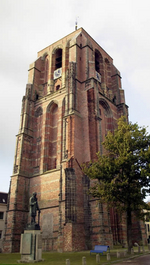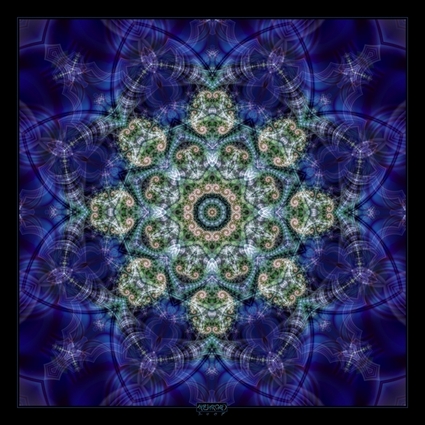Handling editor: Hinke Osinga
BRIDGES LEEUWARDEN
Mathematics, Music, Art, Architecture, Culture
by Bernd Krauskopf, University of Bristol
The annual Bridges conference is one of the leading
conferences in Mathematics and the Arts with the goal of exploring
``Mathematical Connections in Art, Music, and Science.'' While Bridges
has a large and dedicated following, it may not be known so well
beyond the `in-crowd' of regular attendees. In fact, I only heard of
it very indirectly about three-years ago, via a colleague in Montreal,
and attended for the first time when it was held in London in 2006.
 |
|
 |
| Leeuwarden's leaning tower Oldehove. |
M.C. Escher was born close to the Oldehove in the Princessehof in 1898. |
This July Bridges 2008 took place in the city of
Leeuwarden, the Netherlands. This splendid town is the capital of the
Dutch province of Frisia, or Fryslân in the local Frisian
language (which happens to be the language closest to English), which
is generally known as the region where the black and white cows come
from. But it is probably less well known that Leeuwarden is the
birthplace of artist M.C. Escher, who was born there 110 years ago.
This fact was the direct reason for the choice of location, and
Escher's work was celebrated in many different ways. A real highlight
was an exhibition of originals of some of his most famous prints. What
a treat to be allowed to scrutinize the incredible mathematical
and technical craftsmanship of classics such as
Belvedere and
Circle Limit III.
 |
Fractal artwork by Mehrdad Garousi;
from Bridges 2008 Gallery. |
The atmosphere at Bridges 2008 was quite special:
it felt like a mathematical holiday camp! People from all over the
world and with all kinds of backgrounds came together for this
meeting, driven by a passion for mathematical arts. The programme was
very varied, as is evidenced by the conference proceedings of more than
450 pages. There truly was something to discover for everyone: from
abstract mathematics, such as Kleinian groups and tesselations of
space, via all kinds of mathematical puzzles and toys to artwork
including painting, paper art and sculpture. Apart from a stimulating
series of plenary and contributed talks, there were several events
that are Bridges traditions. An exhibition of mathematical art by
participants served as the heart of the conference and a natural
meeting place. The last day of the conference was as always a Family
Day, effectively a mathematical street fair in the center of
Leeuwarden. A real highlight was the excursion: a bus tour to seven
small churches in villages around Leeuwarden, each featuring an
exhibition of work by a different artist. The
organizing committee, and especially
local organizer Cor Wetting of The City of Leeuwarden/The Foundation
Passages, really did an exceptional job; even the weather was
great.
 |
Fractal puzzles by Edmund Harris in their natural environment;
from Bridges 2008 Gallery. |
But what does all this have to do with dynamical
systems? I think a lot, and I will give three specific examples. You
will have seen art of a fractal nature, generated by a dynamical
system of one sort or another. But did you know that it is possible to
construct fractal puzzles with self-similar pieces by considering
Markov partitions of hyperbolic automorphisms of the 4-torus?
Edmund Harris has done just that: participants
could play with his beautiful lasercut wooden puzzles. Another example
is the work by artist/writer/creative developer Paul Prudence, who
takes video feedback to a new and artistic level via software-based
recursion methods. His video installations are truly dynamic and
react to the environment, for example, to musical input. A more
practical example is the work of Erik Moncrieff, who has been
developing mathematical and computer tools for the design of doubly
curved architectural structures. This involves, for example,
determining dynamic wind loads on tent-like roofs. If this does not
mean much to you, his software was used for many of the spectacular
architectural structures at the Beijing Olympics!
I could go on, but the best is to take a relaxing
tour of mathematical art at the online
Mathematical Art Exhibits and to check out the
Bridges Proceedings available at
mathartfun.com. Another great resource
(officially launched at Bridges 2006) is the
Journal of Mathematics and the Arts. And if you
really catch the bug, the
next Bridges conference will take place at Banff Research Station in
July 2009.